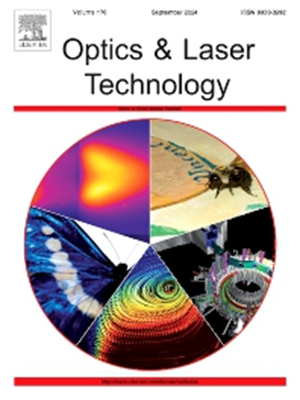Improving microstructure uniformity and mechanical properties of Al-Si coating 22MnB5 steel welded joints by pulsed Laser-TIG hybrid welding
IF 4.6
2区 物理与天体物理
Q1 OPTICS
引用次数: 0
Abstract
The 22MnB5 steel with Al-Si coated exhibits high strength, robust corrosion resistance, and outstanding high-temperature formability, making it a crucial material for automotive lightweight and safety enhancement. However, traditional continuous laser welding (CLW) encounters limitations due to the molten pool’s rapid solidification, which hampers the complete and uniform diffusion of Al elements from the coating into the molten pool. Consequently, Al element segregation occurs in the fusion zone, forming α-ferrite − a critical factor in welded joint failure. To address this issue, the study introduced a novel technology, pulsed laser-TIG hybrid welding (PLTW), designed to overcome these challenges. The novel technology integrates an arc heat source to decelerate the solidification rate of the molten pool. Furthermore, the pulse laser stirs the molten pool, facilitating the complete diffusion of Al elements within it. Consequently, without removing the coating, the formation of α-ferrite was minimized, thereby enhancing the strength and ductility of the welded joint. After hot stamping, compared to CLW, the PLTW welded joint exhibited a more homogeneous microstructure and suppressed fusion zone softening, significantly increasing tensile strength by 13.3% and elongation by 39.1%. Nevertheless, due to the higher heat input from the arc heat source, thinning occurred on both sides of the fusion zone of the PLTW joint. Future research will investigate the use of PLTW with filler wire to address the thinning issue on both sides of the weld, aiming further to enhance the strength and ductility of the welded joint.
求助全文
约1分钟内获得全文
求助全文
来源期刊
CiteScore
8.50
自引率
10.00%
发文量
1060
审稿时长
3.4 months
期刊介绍:
Optics & Laser Technology aims to provide a vehicle for the publication of a broad range of high quality research and review papers in those fields of scientific and engineering research appertaining to the development and application of the technology of optics and lasers. Papers describing original work in these areas are submitted to rigorous refereeing prior to acceptance for publication.
The scope of Optics & Laser Technology encompasses, but is not restricted to, the following areas:
•development in all types of lasers
•developments in optoelectronic devices and photonics
•developments in new photonics and optical concepts
•developments in conventional optics, optical instruments and components
•techniques of optical metrology, including interferometry and optical fibre sensors
•LIDAR and other non-contact optical measurement techniques, including optical methods in heat and fluid flow
•applications of lasers to materials processing, optical NDT display (including holography) and optical communication
•research and development in the field of laser safety including studies of hazards resulting from the applications of lasers (laser safety, hazards of laser fume)
•developments in optical computing and optical information processing
•developments in new optical materials
•developments in new optical characterization methods and techniques
•developments in quantum optics
•developments in light assisted micro and nanofabrication methods and techniques
•developments in nanophotonics and biophotonics
•developments in imaging processing and systems

 求助内容:
求助内容: 应助结果提醒方式:
应助结果提醒方式:


